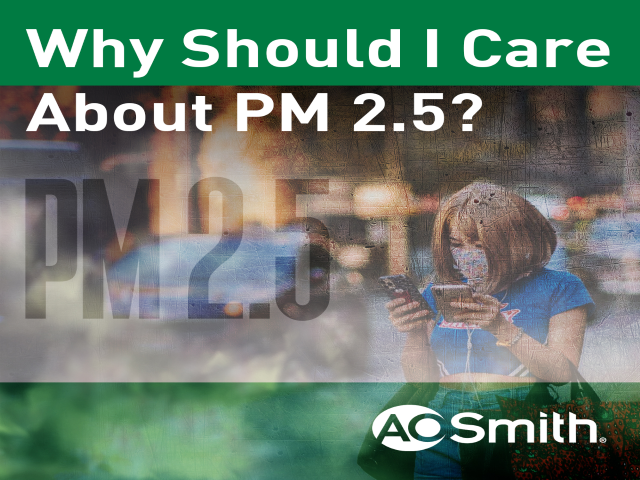Have you encountered hazy outdoors on a sunny day? Do you experience difficulty breathing every time you’re cooking in the kitchen? It may be due to excessive particle pollution in the air. Did you know that in 2020, the Philippines is the 6th Southeast Asian country with the most populated air?
One factor that causes this is the amount of Particulate Matter in the air. It is the mixture of solid particles and liquid droplets found in the air. Particulate Matter (PM) is classified as one of the six major air pollutants that have been indexed by both U.S. Environmental Protection Agency (EPA) and China National Standard.
There are various types of Particulate Matter. The only difference between all its types is the size of the microns. In this article we will discuss the risks of particle pollution caused by PM 2.5.
PM 2.5 or Fine Particles
What is PM 2.5? PM 2.5 is particles 2.5 micrometres in diameter or smaller. It is also known as Fine Particles. How small is 2.5 microns? It is smaller than red blood cells, smallest pollen and most bacteria. It is also 30 times smaller than a strand of hair. PM 2.5 can only be detected using an electron microscope so it can bypass the body's defenses without noticing. These pollutants can get into the deeper parts of your lungs, where they can reach the alveoli and eventually enter the bloodstream.
There are different standards for what is considered healthy air. Here is a list for the maximum PM2.5 exposure set by the The World Health Organization (WHO), The US Environmental Protection Agency (EPA), and China National Standard:
| Maximum 24-hour average | Maximum annual average | |
|---|---|---|
| WHO | 25 ug/m3 | 10 ug/m3 |
| EPA | 35 ug/m3 | 12 ug/m3 |
| CHINA | 75 ug/m3 | 35 ug/m3 |
Metro Manila recorded 93 ug/Ncm PM 2.5 reading just in the first few hours of 2021. It exceeds the maximum 24-hour average set by the WHO, EPA and China. For the US Air Quality Index, 93 ug/m3 is already considered unhealthy. However, according to the China Air Quality Index, it is just lightly polluted.
China Air Quality Index US Air Quality Index
| PM 2.5 Concentration (ug/m3) | Description | PM 2.5 Concentration (ug/m3) | Description |
|---|---|---|---|
| 0-35 | Excellent | 0-12 | Good |
| 35-75 | Good | 12.1-35.4 | Moderate |
| 75-115 | Highly Polluted | 35.5-55.5 | Unhealthy for Sensitive Groups |
| 115-150 | Moderately Polluted | 55.6-150.4 | Unhealthy |
| 150-250 | Heavily Polluted | 150.5-250.4 | Very Unhealthy |
| 250-500 | Severely Polluted | 250.5-500 | Hazardous |
Outdoor exposure to PM 2.5
PM 2.5 or Fine Particles can be either human-made or naturally occurring. Polluted cities have high concentrations of air pollutants especially the places that are close to roadsides since roadsides are surrounded with cars, trucks, buses and off-road vehicle exhausts. Other examples of human-made sources of PM 2.5 outdoors are when people burn woods and heat coal.
When there is no wind or air mixing to carry away the PM 2.5 sources, the air appears hazy so it will be hard to see outside. It is similar in appearance to high humidity or fog. Outdoor air releases more PM 2.5 pollution on days with stagnant air. But even in air that looks clean, PM 2.5 is present. Natural sources of PM 2.5 also occur when there are forest and grass fires.
Dangers of indoor activities
It is important to stay indoors when the PM 2.5 levels outdoors are high. However, PM 2.5 is also produced by common indoor activities. It includes tobacco smoke, cooking fumes, burning candles or oil lamps, wood and coal fires and fuel-burning space heaters.
Keep the doors and windows closed as much as possible but make sure to allow adequate ventilation when needed. Instead of using fans, which can stir up dust and other particles, it is better to use an air purifier. HEPA air purifiers are 99.97% efficient in removing air pollutants.
Impact of PM 2.5 on human's health
Numerous studies show that increases in daily PM 2.5 exposure will result in an increased respiratory and cardiovascular hospital admissions, emergency department visits and deaths. At first, it can cause short-term health effects such as eye, nose, throat and lung irritation, coughing, sneezing, runny nose and shortness of breath but if exposed for a long time, it can lead to worsening of respiratory disease symptoms and cardiovascular effects including heart attacks and death.
Elderly, infants and young children with heart or lung disease can suffer more serious effects from PM 2.5. They are particularly sensitive to fine particulate matter so they could experience immediate symptoms when exposed to high concentrations of these particles. PM 2.5 is very difficult to expel from the body. If you have asthma or other respiratory problems or cardiovascular disease, be extra cautious every time you’re in areas where PM 2.5 levels are high.
Conclusion
Fine particles occur inside and outside the house. Since some of its sources are human-made, it’s better to just reduce exposure from it. You can make it happen by limiting yourself from doing outdoor and indoor activities that produce these particles. Air purifiers will also help in preventing exposure from PM 2.5.

